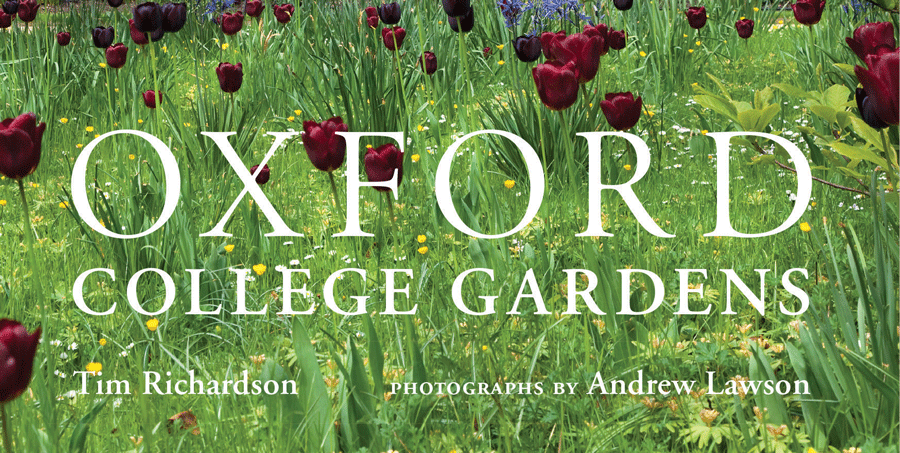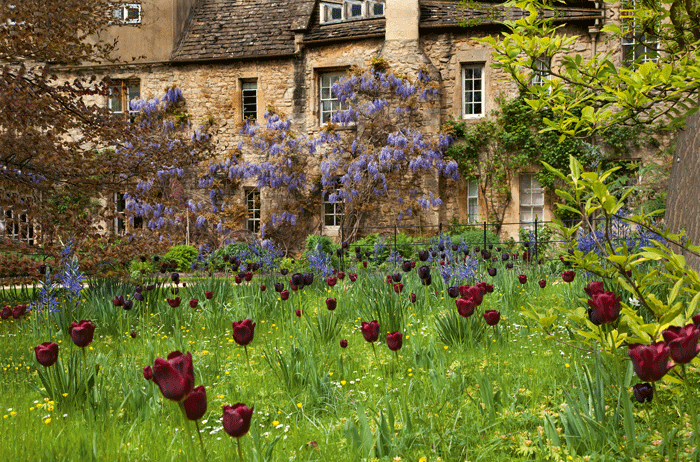Review: Oxford College Gardens
 Our guest reviewer, Susie White, reviews Tim Richardson’s ‘Oxford College Gardens‘ and discovers a ‘delightful, intelligent and absorbing book.’
Our guest reviewer, Susie White, reviews Tim Richardson’s ‘Oxford College Gardens‘ and discovers a ‘delightful, intelligent and absorbing book.’
Rather a long time ago, I spent three years in Oxford studying at the Ruskin School of Drawing, the University’s art school. I painted the view of Mathew Arnold’s ‘dreaming spires’ from one of the surrounding hills, visited friends in wood panelled rooms, photographed plants and glasshouses in the botanic garden, watched Shakespeare acted on Worcester College lawn. The beauty of the buildings, their honey-coloured stone, the different character of each college, got under my skin. But apart from Magdalen’s wisteria and its meadow of snake’s head fritillaries, I don’t remember feeling much for the college gardens. How things have changed.
Reading Tim Richardson’s eloquent and authoritative book has been a joy. He captures the personality of each college, describing both architecture and gardens since they are inseparable. He takes us through the network of expansive quadrangles, quiet corners, passageways, lawns and the usually private fellows’ and masters’ gardens. As he says in his Introduction: “It is only when one penetrates the entrance lodge and starts to wander the quadrangles that a real sense of what the place is about can be appreciated.”
 Tim Richardson (pictured left) is a garden writer, historian and critic who writes regularly for magazines and newspapers including Country Life and the Daily Telegraph. He is an advisor to the National Trust on gardens and Director of the Chelsea Fringe Festival. And he went to Oxford (he was at Pembroke in 1986) so he is best placed to write about Oxford College Gardens and to not only write with authority but to capture their spirit.
Tim Richardson (pictured left) is a garden writer, historian and critic who writes regularly for magazines and newspapers including Country Life and the Daily Telegraph. He is an advisor to the National Trust on gardens and Director of the Chelsea Fringe Festival. And he went to Oxford (he was at Pembroke in 1986) so he is best placed to write about Oxford College Gardens and to not only write with authority but to capture their spirit.
There are 34 chapters listed alphabetically from All Souls to Worcester, the sweep of history taking us from Oxford Botanic Garden, Britain’s oldest, through the modernist sixties design of Wolfson College to twenty-first century additions with glass and sculpture. It really helps that there are maps, lovely clear maps of each college and an overall map at the back showing how they fit together in the city streets. The endpapers show the ancient city, a fascinating comparison with the modern layout.
The descriptions of the character of the colleges are spot-on and often funny. Keble College Chapel is “chromatically hyperactive” and “the whole quad seems to be yelling ‘Alleluleia!’”. Balliol is “politically savvy and in touch with the real world.” There’s a hilarious notice from the Dean of Queen’s about “Behaviour in the College Quadrangles and Gardens”. Anyone thinking of applying to study could do well to read this book.
 (pictured above – Merton College)
(pictured above – Merton College)
Gardens interact with the character of the buildings; each head gardeners response is very individual and sometimes quirky. I particularly enjoyed reading about the extraordinary creations of David Leake, head gardener at Corpus Christi College. He has filled Front Quad with flamboyant planting, with bamboos and hollyhocks, euphorbias and grasses packed against the walls. Just to see his greenhouse in what is known as Small Garden makes me want to visit. Richardson describes it as, “filled with cacti, sempervivums and other tender or succulent plants“, as well as all kinds of objects and artefacts gleaned from the natural world … and the man-made (a shop dummy, religious kitsch, Egyptian relics, jewellery, tiles, bird sculptures, a lobster creel).
 We can vicariously explore private spaces such as the Gooseberry Garden which is, “kept locked and is strictly reserved for college fellow and their guests.” It’s a secret green space with large circles of box hedging echoed by a raised circular pool. As well as the famous colleges – Trinity, Christ Church, New College, Lincoln amongst them – there’s the excitement of the less well known. Green Templeton College, with its backdrop of the Radcliffe Observatory, is a froth of backlit grasses, daisies, penstemons and California poppies.
We can vicariously explore private spaces such as the Gooseberry Garden which is, “kept locked and is strictly reserved for college fellow and their guests.” It’s a secret green space with large circles of box hedging echoed by a raised circular pool. As well as the famous colleges – Trinity, Christ Church, New College, Lincoln amongst them – there’s the excitement of the less well known. Green Templeton College, with its backdrop of the Radcliffe Observatory, is a froth of backlit grasses, daisies, penstemons and California poppies.
It is interesting to see how contemporary gardening has influenced some of the designs, such as the Merton Borders in Oxford Botanic Garden based on plant communities from the USA or the autumn border designed by Nori and Sandra Pope.
This beautiful book first came out in 2015 (priced then at £40). This is a new revised edition. It’s illustrated throughout with photographs by leading photographer Andrew Lawson who lives in Oxfordshire. Living not so far away, and being a good gardener himself, meant that he could visit the college gardens throughout the seasons and really convey the atmosphere of each. There’s a pleasing variety to the layout, allowing the photographs to interact with the writing with the occasional double page such as Magdalen’s fritillary meadow.
It doesn’t matter if you don’t think you will ever get to see these gardens in reality; this is a delightful, intelligent and absorbing book to enjoy. But, quite possibly like me, you will be inspired to plan a trip to Oxford to steep yourself in these varied and horticulturally exciting spaces.
 (Pictured above – Worcester College)
(Pictured above – Worcester College)
To visit any of the gardens you need to check individual opening times and prices.
‘Oxford College Gardens’ by Tim Richardson. Photographs by Andrew Lawson. Published by White Lion Publishing. New edition ISBN 9780711239784 Price £25.
All photographs strictly © of the publisher, credit Andrew Lawson. We acknowledge a review copy kindly sent by the publishers.
Susie White is a Guardian Country Diarist and Member of the Garden Media Guild. She is also a RHS Listed Speaker. Her website is: www.susie-white.co.uk and she tweets as @cottagegardener

